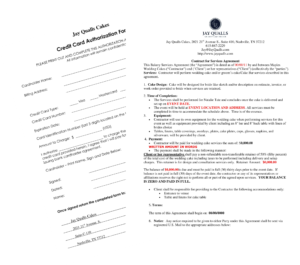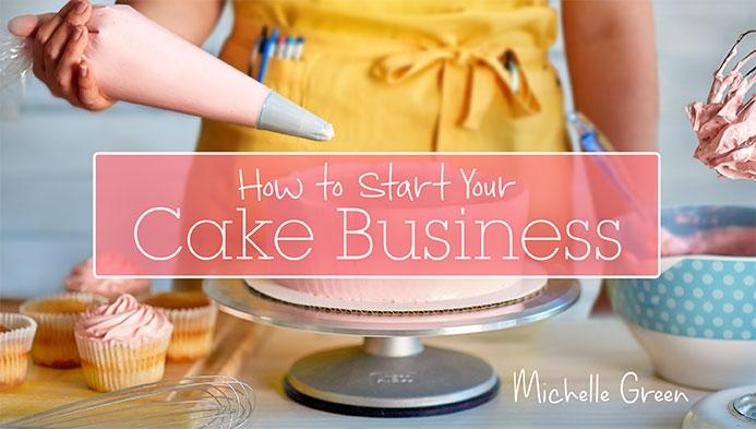Wedding Cake Contracts 101
By Jay Qualls
Many things have changed in the cake business over the past several years including wedding cake contracts. One significant change I believe has been pushed to the back of the oven is the proper way to execute a contract with a cake client. A contract becomes much more important for wedding cakes and larger special occasion cakes because many times there is a significant amount of money being exchanged between you, the seller, and your client, the consumer.
 The first very important factor to take into consideration when negotiating with a cake client is to not promise anything you cannot produce or deliver. The most effective way to protect you, your business and the consumer is to execute a viable, well-outlined contract for the service you are providing to your client.
The first very important factor to take into consideration when negotiating with a cake client is to not promise anything you cannot produce or deliver. The most effective way to protect you, your business and the consumer is to execute a viable, well-outlined contract for the service you are providing to your client.
It is very important that you list all the items you will be providing to your client. If you are responsible for providing the linens, flowers, cake plateau, silverware, cake topper, or even the plates or utensils, these items should be listed explicitly in the wording of your contract.
Time is of the essence! Clarifying with the wedding planner, event coordinator, or directly with the client about the time of the event is also very important. I typically note the time of the ceremony, and use that time as a guide for delivery and setup. I typically give a two-hour window prior to the ceremony time for setup and delivery. Note this timing in the contract and adhere to your own rule.
List all dollar amounts in numerals as well as in written words, as you would if you were writing out a check. This leaves no ambiguity when documenting costs.
It is important that if any changes are made to an executed and signed contract, these changes must be done in writing via snail mail or electronic mail. I prefer electronic mail because I have a permanent copy on file for future reference.
It is industry standard to collect a 50 percent retainer for the total amount due from the client. It is also noteworthy to mention you should never call your retainers a “deposit,” but rather a “retainer.” A deposit is refundable and a retainer is not. By paying a retainer, the client is paying you for your time in meeting with them, preparing samples, and design and consultation services. By paying 50 percent up front, this is a commitment by the client that is an investment large enough not to find another baker to do their cake, and insurance for you to be able to predict future revenue.
You should have a very comprehensive software program to create estimates and invoices, and to track accounts receivable and accounts payable, as well as a method to receive and record payments.
In the event there should ever be any disagreement or discrepancy regarding the product you deliver to your customer, there should be a clause in your contract stipulating that arbitration and mediation takes place in your hometown or jurisdiction. This basically gives you an advantage during negotiating.
It is also important to limit your written and verbal communication to your client. In other words, anything you say or write can be used against you. If you have a disgruntled or dissatisfied customer, respond in 10 words or less if at all possible. Saying less will help protect you in the long run, especially in written business communication.
Last but not least, send a detailed estimate to your client outlining what you discussed and ask them to respond in writing with their acceptance of the estimate as written. Once they agree to the estimate, create an invoice, which at that point creates accounts receivable in your company. This is when the contract should be executed and signed by you and your client.
I have provided you with sample copies of my contract that you may customize and use for your own purposes. I am also providing a copy of my credit card authorization form, which you should keep on file for clients who choose to pay by credit card. This form should be signed and included when you email the client the contract. Your client should then sign and return the form to you with the signed contract.
| The contract form can be found here | |
| The credit card authorization form can be found here |
 Author bio: Jay Qualls is owner of Maples Wedding Cakes, Jay Qualls Cakes and Jay Qualls Holding, LLC, and is creator of the Jay Qualls Fondant Fabric. He has studied under and worked alongside some of the greatest sugar artists in the industry, and has become one of the nation’s top cake artists to the stars. He has designed for a number of celebrity clients, and was featured in Martha Stewart Weddings 15th Anniversary Issue, as well as Southern Living Weddings, US Weekly and many other publications. Jay was also a top competitor on TLC’s Next Great Baker, and now teaches classes, demonstrates his unique sense of style and methods for cake design, and provides business consulting services to shop owners and home bakers throughout the U.S. and Canada.
Author bio: Jay Qualls is owner of Maples Wedding Cakes, Jay Qualls Cakes and Jay Qualls Holding, LLC, and is creator of the Jay Qualls Fondant Fabric. He has studied under and worked alongside some of the greatest sugar artists in the industry, and has become one of the nation’s top cake artists to the stars. He has designed for a number of celebrity clients, and was featured in Martha Stewart Weddings 15th Anniversary Issue, as well as Southern Living Weddings, US Weekly and many other publications. Jay was also a top competitor on TLC’s Next Great Baker, and now teaches classes, demonstrates his unique sense of style and methods for cake design, and provides business consulting services to shop owners and home bakers throughout the U.S. and Canada.
You can reach Jay at http://www.thefrostedaffairbyjayqualls.com.



